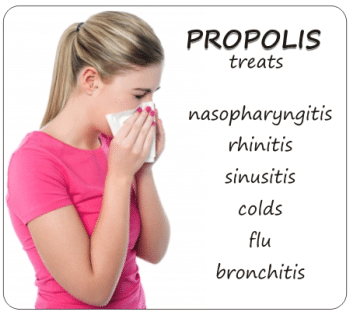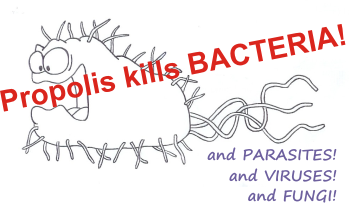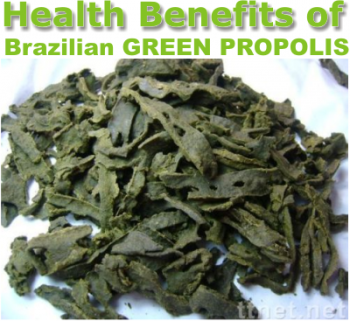Our folk medicine is teaching us how to take propolis, from its experience. It’s good to know what worked for centuries, and learn how to adjust the dosage to our daily conditions.
Propolis tincture works in many cases, where classic drugs fail.
The dosages described here are not coming from scientific research or medical reviews. These are traditional folk remedies used in Romania for hundred of years. (Romania is a South-Eastern country with international well-recognized tradition in beekeeping and apitherapy. Nicolae V. Ilieşiu, the famous inventor who created Apilarnil, the product made of male bee brood, was also Romanian.)
These are dosages for adults. For children it is usually halved.
Weakened immune system
30 – 40 drops, 4 times per day, for three weeks.
Any kind of internal infectious disease with fever:

15 drops of propolis tincture per day
Bad symptoms of monopause in women:
5 drops per day for a whole year
Prostate conditions:
15 drops per day
Hypertension:
15 drops per day till complete recovery (!)
Kidney and liver conditions:

20 drops of propolis tincture in 100 ml of warm water, twice per day, till recovery.
Angina, pharyngitis, flu or to avoid complications:
20 drops in 20 ml warm water, twice per day, and gargling several times per day.
Stomach ulcer or enteritis
20 drops in 10 ml of warm milk, daily, on an empty stomach.
Corns and keratitis:
Before bedtime, soak a piece of cotton in tincture and apply it on the painful spot. During day use the propolis + salicylate ointment. Remember that keratitis can remain painfull for whole days.
Skin conditions:
If the skin supports rubbing alcohol, then rub that place with propolis tincture. If the skin is too sensitive, mix the tincture in an ointment.
For herpes: use a pipette to drop the tincture straight on the wound. It should not be touched with anything. D o this 2-3 times per day. Compared to conventional treatment, time of healing is reduced 3 or 4 times in 80% of cases.
Irritation after shaving:
mix 20 drops of tincture in 10 ml of warm water and after shaving wash your face with it.
Tuberculosis:
15 drops of tincture taken 3 times per day. Also, twice per week, add 50 drops of tincture in ¼ l hot water and inhale it.
High blood alcohol

A person can be sobered up if he/she drinks 25 drops of tincture in 100 ml cold water.
Mycosis:
Wash the affected areas with tincture.
Stomach pains:
25 drops in 100 ml in 100 ml water. The pains will soon disappear.
Intestinal parasites, giardiasis:
25 drops in 100 ml in 100 ml water, daily on empty stomach, for 22 days.
For giardiasis: 50 drops on a piece of bread, 4 times per day, 30 days.
Tooth ache:
Clean propolis put on the painful gums or on the carious tooth will relieve pain and prevent infection. Take a cotton swab and soak it in propolis tincture and apply on the painful place.
Old wounds:
The wound is first washed with a greater burdock extract (Arctium lappa), and than spread with propolis tincture, several times per day. After a short period of time, edemas and pains go away.
First degree burns:
Wash the wound with tincture several times per day. It will not form vesicles. But, it will sting like hell.
Today apitherapy offers a great variety of products made with propolis. Some therapists do not recommend taken the ethanol propolis tincture with water, because some of its constituents will precipitate. Tradition must also have known this, and reached the specific dosage according to experience. Considering the lack of technology in the past, experience was the only tool teaching therapist what to prescribe.
Today there are propolis tinctures which are water based, so there really is no problem with precipitation. Or with giving it to a child.
Recommended book:
Bee Pollen, Royal Jelly and Propolis (Woodland Health Series) It cannot be found in an ebook form, but personally I’ve never managed to get comfortable with an ebook unless I had a romantic book/novel to read. A book that I had to study, must have paper to write on, to make notes and not depend on battery.
Anyway, the book is not only a book on therapy, but describes the products more widely. The author, Rita Elkins, MH, discusses the nutrients found in bee products as well as exciting new research that supports many healthful uses for these products.
Toxicology
Burdock G.A., in his study “Review of the biological properties and toxicity of bee propolis.”, reviewed many animal toxicological studies in animals. He says that an intake of 4000 mg/ kg, per day, there are no measurable effects. He establishes a NOEL (no effect level) at 1400 mg/kg per day for an adult.
As a rule, a safety margin of 100 is assumed for drugs and food additives. This means that a maximum of 14 mg /kg/day or 980 mg per day for a 70 kg adult is a daily acceptable intake.
In tinctures, the percentage of the propolis is calculated according to the amount of propolis used. YET, the actual concentration of propolis components is only half of it. That’s because the alcohol soluble resin is about 50% of the total propolis.
20 drops of 20% tincture, taken 3 times per day, corresponds to about 1 g tincture, or about 200 mg of propolis per day. Which is far from the maximum of 1400 mg per day.
How to make propolis tincture:
If you are a beekeeper you surely know how to do it. But if you only know a beekeeper, friend, acquaintance or neighbour, then you can buy some raw propolis from him and make your own propolis. It’s not difficult at all and you don’t need any fancy equipment.
Tinctures are prepared in ethanol, glycol and olive oil. The latter two are better for skin and cosmetic applications. Ethanol is the best solvent for extracting the bioactive substances of propolis (balsam). Propylenglycol can
dissolve less propolis, 20 g per 100 ml glycol can be dissolved. Glycol tinctures are highly antioxidant and can
be used in skin protection.
The dosages recommended above use propolis tincture made with ethanol (aka alcohol, spirits, ethyl alcohol, or drinking alcohol, the principal type of alcohol found in alcoholic beverages, produced by the fermentation of sugars by yeasts.) The concentration can vary from 70 to 90 degrees.
For human use only non-toxic solvents should be used, ethanol of Pharmacopeia quality is the best choice.
Method #1:
Use 100 grams of alcohol 80° -86°, and 20 grams of hard propolis, kept in the refrigerator.
The alcohol is mixed with propolis and poured into a vessel, heated to 30° C to 40° C and mixed well. The procedure is repeated 6-7 times for a week, then it is left to settle and filtered.
Method #2:
For every 100 grams of alcohol 60º (or 90), add 30 grams of hard propolis, previously kept in a refrigerator. The propolis should be cut into small pieces, and placed in a dark bottle, along with the alcohol. Keep it like that for two weeks and shake ot 2-3 times a day. Strain with a very dense mesh.
The general recommendation is to take the tincture with honey, but you can also use sugar or bread. Administered water or directly into the mouth, some tincture constituent precipitate.
Not recommended to allergic people, even to those who notice a slight sensitivity to propolis (though these are extremely rare cases).
====================================
====================================
Picture By emk, via http://mrg.bz/gXGdUc





Can children take propolis DAILY for long period of time?
Will propolis caused precocious if long time taken by children?
Thank you very much
Hi Angela,
Children can take propolis for a long period of time, yes. However the dose should be lower, not a therapeutic one. As for his/her being precocious is hard to tell, because you cannot compare it with how he/she would have grown without propolis. Propolis boosts immunity and helps the entire body but I don’t think it can develop other special skills in a child.
Laura
Hi there, I am going to make propolis tincture using grain alcohol of 96% which is the best solvent to extract the raw propolis. However, such high degree of alcohol concentration is neurotoxin, i just wonder what is the safe dosage daily so that I won’t have the alcohol poisoning or addiction if I take this alcohol-based tincture for a long time . Thanks.
Such a high degree is necessary to extract all the good stuff from propolis. When you take it, you’ll take it with with honey. Which is a liver&brain protector. How to protect liver while drinking – read this.
The quantity you drink is not much, but if you do it on a regular bases, you fear the Chinese drop, I understand. However, as I said, take it with honey and remember that naturopaths also recommend having a 3 months break after 6 months of treatment.
Give it a try and maybe have the liver markers tested after.
All the best!
Laura
Hi Laura! Cheers from Costa Rica.
We need to register our Propolis Tincture as a Natural drug to able to commercialize…
But I need to understand how to measure the grams of propolis in our tincture.
Canadian Pharmacopeia says the dosage is 0.2-0.6 grams per dayhttp://webprod.hc-sc.gc.ca/nhpid-bdipsn/monoReq.do?id=147&lang=eng
My tincture was made with 500g raw propolis in 2L of ethanol 96
What is the concentration per ML of propolis in my tincture? How can I support a method of analysis that is accepted (from a Pharmacopeia)
Hi Diana,
If you used 500 g of raw propolis into a 2l bottle of alcohol, then you have a a concentration of 0.25 g pf propolis per 1 ml tincture. 3 ml per day, would be a good recommended doze for an adult. Anyway, a naturopath should be consulted for more accurate doses per each disease. And, of course, you should check the recommendation for this type of supplement, which is accepted in your country. From what I’ve seen, Costa Rica has good beekeeping tradition, ask them, too.
There is significantly a bundle to know about this. I presume you made sure nice factors of the knowledge of propolis tincture.
What are good measurements for a Propolis Tincture made with Olive Oil. I do not consume alcohol in any amount!
Hi Miss Laura , i actually did that using alcohol and once done i put it in the bottle and was readily for sale but unfortunately it vaporized. How can i prevent that?
I think it depends on how you are taking it and what you are taking it for. I make a propolis tincture, a propolis oil and just have plain propolis. Each one is used a little differently.
Yes indeed, you are perfectly right. Thank you for your input.
Laura
We have studied propolis 30 years and professionaly produce propolis with high 2-4 times effective flavonoids than others;solved the world’s purify tech problems,and invent fingerprint spectrum inspection technology.propolis liquid used as treatment of diseases,powder worked as food and cosmetics additive; we will hold Chinese Apitherapy Congress in Beijing on 13-15th,October 2017, will invite famous apitherapists,acupuncturists who own 30 years experiences;you are wellcome to join
http://www.leyisheng.com
http://www.defengtang.com
Skype:13520860035
Wechat:13520860035
WhatsApp:+86 13120179219
Hi Hellina,
Hope you doing well.i need propolis. Kindly Help Me Dear.
1) In which shape can u provide me.I mean in capsule form or in jelly form or
tincture??
2) How much minimum quantity will you provide me and also the price and
shipping charges etc
3) Is there any difference between the propolis and the Royal jelly??
Dr.Rai Omar
Pakistan